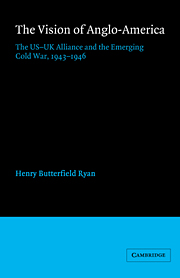Book contents
- Frontmatter
- Contents
- ACKNOWLEDGEMENTS
- INTRODUCTION
- PART I STRENGTHENING THE TIES: THE EFFORT AND THE PROBLEMS
- PART II FOREIGN CRISES THAT DEMONSTRATE GREAT BRITAIN'S PROBLEMS
- INTRODUCTION
- 5 Background and build-up
- 6 Involvement of Great Britain and the United States
- 7 Yalta and after
- 8 Truman: the new factor
- 9 The gathering for the San Francisco Conference
- 10 Between San Francisco and Potsdam
- 11 Concluding thoughts on the Polish crisis
- 12 Background of the crisis
- 13 1944, the critical year
- 14 The role of the press
- 15 The crisis peaks
- 16 America dives in
- CONCLUSION
- NOTES
- BIBLIOGRAPHY
- INDEX
8 - Truman: the new factor
from PART II - FOREIGN CRISES THAT DEMONSTRATE GREAT BRITAIN'S PROBLEMS
Published online by Cambridge University Press: 07 December 2009
- Frontmatter
- Contents
- ACKNOWLEDGEMENTS
- INTRODUCTION
- PART I STRENGTHENING THE TIES: THE EFFORT AND THE PROBLEMS
- PART II FOREIGN CRISES THAT DEMONSTRATE GREAT BRITAIN'S PROBLEMS
- INTRODUCTION
- 5 Background and build-up
- 6 Involvement of Great Britain and the United States
- 7 Yalta and after
- 8 Truman: the new factor
- 9 The gathering for the San Francisco Conference
- 10 Between San Francisco and Potsdam
- 11 Concluding thoughts on the Polish crisis
- 12 Background of the crisis
- 13 1944, the critical year
- 14 The role of the press
- 15 The crisis peaks
- 16 America dives in
- CONCLUSION
- NOTES
- BIBLIOGRAPHY
- INDEX
Summary
Churchill and the Foreign Office had established a bridgehead with Roosevelt. They had brought him at least to the point where he would express concern to Stalin over Soviet diplomacy. After Roosevelt's death, they attempted to go further with Truman who was nearly as new to foreign affairs as he was to the presidency. Highly impressed with the importance of the presidential office, he assumed it at a challenging time, Soviet intransigence from the Western point of view then being at a peak. He was far less vulnerable than Roosevelt to threats to the UNO, with which he had had little involvement by then and to which he showed much less personal or ideological dedication. He was, however, convinced that Russian help would be needed in the Pacific war. This conviction did not prevent him from exploding violently at Molotov before the San Francisco Conference, but it did, perhaps along with other considerations, prevent him from heeding Churchill's persistent calls to push the Western armies eastward beyond the demands of military necessity. Nor would he agree to leave US forces in predesignated Soviet zones until political concessions were gained from the Russians, as Churchill suggested. In his memoirs, Truman said, ‘Russian tactics and aims were, of course, of much concern to us, and I agreed with Churchill on the seriousness of the situation. But I could not agree to going back on our commitments.’
- Type
- Chapter
- Information
- The Vision of Anglo-AmericaThe US-UK Alliance and the Emerging Cold War, 1943–1946, pp. 99 - 102Publisher: Cambridge University PressPrint publication year: 1987



